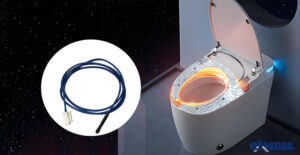 With technological advancements and rising living standards, smart toilets have gradually transitioned from “high-end appliances” to standard bathroom fixtures. Particularly in winter or colder regions, the seat-heating function is especially favored, eliminating discomfort from cold contact. Behind this feature lies the precise “control” of NTC temperature sensors—key to maintaining constant seat temperature and critical to thermal safety during use. Today, we unveil the technological secrets behind smart toilet seat temperature stability.
With technological advancements and rising living standards, smart toilets have gradually transitioned from “high-end appliances” to standard bathroom fixtures. Particularly in winter or colder regions, the seat-heating function is especially favored, eliminating discomfort from cold contact. Behind this feature lies the precise “control” of NTC temperature sensors—key to maintaining constant seat temperature and critical to thermal safety during use. Today, we unveil the technological secrets behind smart toilet seat temperature stability.
I. Working Principle and Structure of Smart Toilet Heating Systems
- Working Principle:
The heating element in smart toilet seats primarily uses electric heating components, such as resistance heating wires or aluminum-film heating plates. When a user sits down, the seat detects pressure and automatically activates heating, maintaining a comfortable temperature range of 32°C to 38°C. This design enhances comfort and effectively alleviates discomfort during winter use.
- Structural Components:
The heating system consists of three main parts:
- Heating Unit: The core heating component (e.g., resistance wire or aluminum-film plate) generates and rapidly transfers heat across the seat surface.
- Temperature Monitoring Module: Typically employs an NTC temperature sensor to monitor seat temperature in real time, transmitting data to the control board for precise temperature regulation.
- Smart Control Board: Processes data from the sensor and uses PID (Proportional-Integral-Derivative) algorithms to adjust current intensity, ensuring stable temperature control.
II. Role of NTC Temperature Sensors in Smart Toilet Seat Heating Systems
Smart toilet seats are typically set between 32°C and 38°C—a range considered optimal for human contact, balancing comfort with burn prevention. To cater to personalized preferences, some premium models allow users to fine-tune temperatures for an optimal experience.
The NTC (Negative Temperature Coefficient) sensor performs two critical functions:
- Precise Temperature Control & Stability:
- Mounted on the heating unit’s surface, the NTC sensor monitors real-time temperature and relays data to the control board. The board then dynamically adjusts power output to maintain the user’s target temperature.
- Example: The control board instantly modulates current if the sensor detects a deviation exceeding ±0.5°C from the set value. This closed-loop system achieves high-precision temperature stability, preventing discomfort from fluctuations.
- Overheat Protection & Safety Alerts:
- To ensure safety, the maximum seat temperature is capped at 40°C. If abnormal heating occurs (e.g., due to prolonged use), the NTC sensor immediately detects excess heat. It signals the control board to activate safeguards (e.g., reducing power or cutting off heating), preventing burns.
Conclusion:
As innovative toilet functionalities evolve, demands for NTC sensor performance increase. For instance, high-end models with multi-level temperature adjustments require faster response times, while sensors must also resist moisture and corrosion in humid bathrooms for long-term reliability. EXSENSE now offers customized NTC solutions for smart toilets. Through in-house developed high-precision chips and optimized encapsulation technology, these solutions deliver comfort and safety, making NTC sensors an invisible yet indispensable pillar of smart living.
